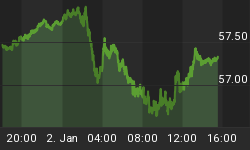Gold Falls with Dollar, "Technicals Bearish" as Deflation Spied, Summer Lull "Reliable"
THE SPOT PRICE OF GOLD recovered two-thirds of yesterday's 1.4% drop for US investors in London on Tuesday, but it dropped further against all other major currencies as the Dollar fell hard on the forex market.
"Gold is currently testing its 100-day moving average (925.24)," says a technical note from London market-makers Scotia Mocatta. "A substantial break below would be bearish [but] throughout April the 100-day proved a poor signal.
Several other technical price indicators "have turned increasingly bearish over the last several trading days," note the bullion dealers, pegging support at $918 and resistance at Friday's close of $939.30 per ounce.
Crude oil meantime bounced back above $71 per barrel while Asian stocks closed the day 2% lower on average as the Japanese Yen knocked ¥2 off the Dollar, pushing it down to a two-week low beneath ¥96.50.
Tokyo and Hong Kong gold dealers reported "light physical buying" according to Reuters, but with the wedding season in India - the world's hungriest physical gold market - nearly over, the latest Refining Monitor from Mitsui warns that Gold Coin demand worldwide is also easing.
The Hindu festival season that peaks with Diwali in late October won't begin until late August, typically creating a "summer lull" in Gold Prices during both bull and bear markets across the last four decades.
"It's a seasonal play that has over 30 years of reliability," says Ira Epstein, head of the Ira Epstein division of Linn Group, quoted by the Wall Street Journal online.
"I know everybody says, 'This year is different than any other year.' But they say that every year."
Ahead of Wednesday's US consumer-price data, annual inflation in the 16-nation Eurozone fell to 0.0% in May the Eurostat agency announced Tuesday, adding 0.1% to the cost of living month-on-month.
The UK's consumer-price index ticked higher in May, pushing year-on-year inflation to 2.2% from the 1.9% that analysts had forecast and holding above the Bank of England's 2.0% target for the 20th month running.
So-called "core inflation" stripping out food and fuel reached 1.6% annually, up from 1.5% in April. The old Retail Price measure remained negative, but rose to -1.1% year-on-year and showed a rise of +0.6% for the month.
New data also showed Germany's ZEW survey of economic sentiment leaping for the third month on the trot, approaching the best levels since August 2008.
Labor costs in the Eurozone rose 3.7% year-on-year during the first quarter.
"I think gold is not going anywhere, not $5,000 an ounce like many people are predicting," said Robert Prechter, head of Elliott Wave International, at the Reuters Investment Outlook Summit in New York yesterday.
"It seems to me that the most popular opinion out there right now is hyperinflation. I think that we are in an opposite environment - a deflationary environment," said Prechter, author of the best-selling Conquer the Crash, hich predicted a deflationary US slump seven years ago.
"Unfortunately, in this environment, what creditors...and debtors need the most are dollars, so I think the main thing that will return to substantial demand when deflation bites again is the Dollar."
But hosting this week's inaugural summit of political leaders from the emerging-economy "BRIC" giants of Brazil, Russia, India and China, Russian president Dmitry Medvedev today refined his finance minister's statement that the US Dollar is in "good shape" by proposing to widen the range of reserve currencies held by central banks worldwide.
"No currency system can be successful if we have financial instruments denominated in just one currency," Medvedev said at a conference with China. "We must strengthen the international financial system not only by making the Dollar strong, but also by creating other reserve currencies."
Medvedev's economic adviser Arkady Dvorkovich said in a press briefing that Russia may switch part of its currency reserves to bonds issued by Brazil, China and India.
He also said the International Monetary Fund's reference basket - the Special Drawing Right (SDR) - should inclue Chinese Yuan and Gold Bullion as well as US Dollars, Euros, Yen and Sterling.
















